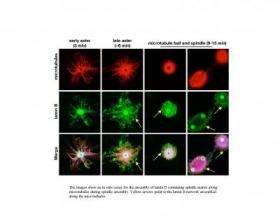Scientists deconstruct cell division

The last step of the cell cycle is the brief but spectacularly dynamic and complicated mitosis phase, which leads to the duplication of one mother cell into two daughter cells. In mitosis, the chromosomes condense and the nucleus breaks down.
Fibrous structures called spindles form, which then move the chromosomal material toward opposite ends of a cell and help partition other cell contents. If something goes wrong, diseases such as cancer can arise. Scientists have tried for years to unravel the process of spindle assembly. Now, researchers at Carnegie's Department of Embryology have found that two proteins— dynein and Nudel—involved in other cell-division functions, are essential to regulate assembly of the spindle matrix.
"The mechanisms that cells use during division to partition both chromosomes and regulatory factors into their daughters are widely recognized as among the most fundamental processes in all of biology. During the last several years no one has done more than Yixian Zheng to broaden our understanding of how dividing cells control these critical events," said Allan Spradling, Department of Embryology director.
"To ensure proper cell division, the mother cell needs to separate its genetic materials, the chromosomes, equally, but also partition its cellular content properly into daughter cells," explained co-author Yixan Zheng. "Cell division allows a fertilized egg to develop into multicellular organisms with different types of cells. It also replenishes adult tissues, such as skin and bones. Forming a spindle requires the assembly of a 'skeleton' from tube-like microtubules and the construction of a poorly defined scaffold called a spindle matrix."
In 2006, Zheng and colleagues discovered that a protein found in the nucleus during the interphase of the cell division cycle, called lamin-B, is a structural component of the spindle matrix (Science 31 March 2006, 311: 1887-1893). Based on this finding, she and colleagues have now isolated the spindle matrix. Interestingly, both dynein and Nudel are components of the spindle matrix. Nudel binds to lamin-B and brings it to microtubules where both Nudel and dynein then help the lamin-B assemble into the spindle matrix. The lamin-B-containing spindle matrix, in turn, works with microtubules to orchestrate spindle assembly and cell division.
"Isolating the spindle matrix and identifying its components has also allowed us to show that the matrix contains not only factors important for spindle assembly, but also proteins essential for cell fate choices," remarked Zheng. "We believe that by understanding how the spindle matrix is assembled in mitosis, it will be possible to understand how, after mitosis, two daughters can chose to become the same or different cell types—a decision that cells need to make both during the development of an organism and during the maintenance of adult tissues."
The research is published on line in the February 8 Nature Cell Biology (www.nature.com/ncb/).
Source: Carnegie Institution















